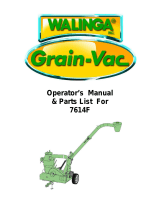
Owner’s Manual #513691 9 A118/D118 Model Machines
A. Prepare 2 gallons of sanitizing solution. Follow
the manufacturer’s instructions for preparing the
sanitizing solution
B. Pour the sanitizing solution into the hopper.
C. Place the switch into the CLEAN position to start
the auger rotating.
D. Check for leaks at the front door seals and in the
drain tray.
E. While the cylinder is being sanitized, use a
sanitized soft bristle brush dipped in sanitizing
solution to clean the hopper and hopper cover.
F. After 5 minutes, open the spigot to drain the
sanitizing solution.
G. When the solution has drained, place the switch
in the OFF position. Allow the freezing cylinder
to drain completely.
The machine is now sanitized and ready for adding mix.
3.9 FREEZE DOWN AND OPERATION
A. Sanitize immediately before use.
B. Fill the hopper with mix. Open the spigot and drain
a small amount of mix to remove any remaining
sanitizer.
D. Place the switch in the ON position.
NOTE
After the drive motor starts, there is a delay before
the compressor starts.
F. After 15 to 20 minutes the product will be at
consistency and will be ready to serve. Freeze
down time may vary depending on mix type and
ambient temperatures.
G. To dispense, pull or push the spigot handle. To
prevent from dispensing, push the spigot lock clip
upwards.
H. Do not operate the machine when the ADD MIX
light is on. Rell the hopper immediately.
3.10 DAILY DEFROST
The machine must be placed in defrost mode on a daily
basis to prevent large ice crystal buildup.
A. Place the switch in the CLEAN position.
B. The auger rotates continuously for 20 minutes.
After 20 minutes the defrost mode begins. The
auger rotates for 90 seconds every 7 minutes
and the diagnostic light is lit.
C. Keep the machine in defrost mode for at least 4
hours daily.
D. Place the switch in the ON position to return
to freeze down product and return to normal
operation.
3.11 CONSISTENCY ADJUSTMENT
The consistency adjustment screw is located behind the
access plug on the right side panel. Remove the plug to
access the screw.
To adjust consistency, use a at head screwdriver. Turn
clockwise for thicker product and counterclockwise for
thinner product. Allow 15-30 minutes for the consistency
change to show up in the product.
3.12 PREVENTIVE MAINTENANCE
Stoelting recommends that a maintenance schedule be
followed to keep the machine clean and operating properly.
A. DAILY
1. The machine must be placed in defrost mode for
4 hours to prevent ice buildup (see Section 3.10)
2. The exterior should be kept clean at all times to
preserve the luster of the stainless steel. A mild
alkaline cleaner is recommended. Use a soft cloth
or sponge to apply the cleaner.
B. WEEKLY
1. Check o-rings and rear seal for excessive wear
and replace if necessary.
2. Remove and clean the drip tray:
a. Remove the drain tray
b. Gently lift the drip tray upwards to disengage
it from the support and pull it out.
c. Clean the drain tray and drip tray. Clean behind
the drip tray and at front of the machine with
a mild detergent.
d. Replace the drip tray and drain tray.
C. QUARTERLY
Air Cooled
The air-cooled condenser is a copper tube and aluminum
n type. Condensing is totally dependent upon airow. A
plugged condenser lter, condenser, or restrictions in the
lower vented panels lowers the capacity of the system
and may cause damage to the compressor.
The condenser must be kept clean of dirt and grease.
The machine must have a minimum of 3” ventilation on
the right and left sides of the unit for free ow of air. Make
sure the machine is not pulling over 100° F (37° C) air
from other equipment in the area.
The condenser and condenser lter require periodic clean-
ing. To clean, refer to the following procedures.
NOTE
The machine has a two lters. Both lters must be
cleaned.
A. Remove the drain tray. Gently lift the drip tray
upwards to disengage it from the support and
pull it out.























